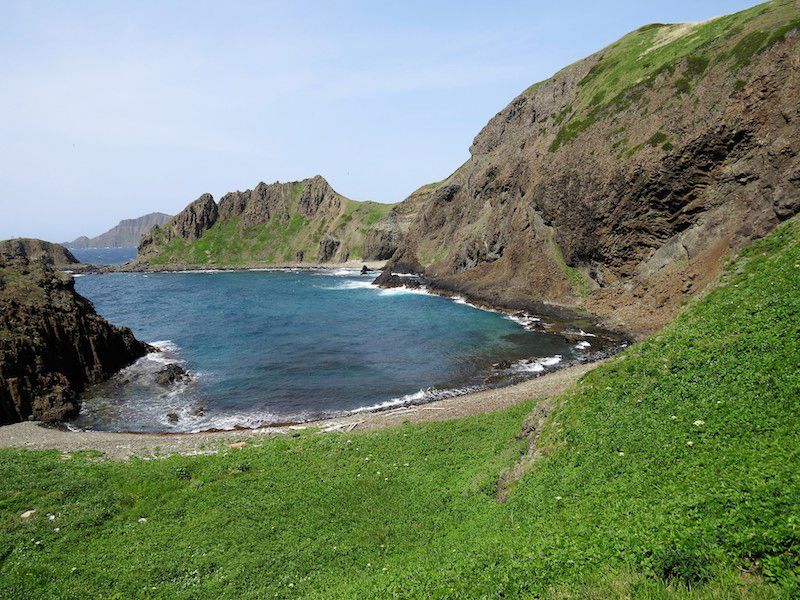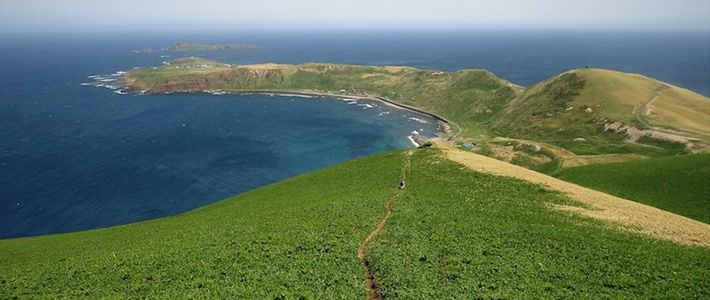
Touring Japan’s Far-Flung Islands
Rebun, Hokkaidō: Japan’s Northernmost Island Stirs the Traveler’s Heart
Guideto Japan
Travel Food and Drink Culture- English
- 日本語
- 简体字
- 繁體字
- Français
- Español
- العربية
- Русский
Getting to Know the Island on Foot
The best way to savor what Rebun Island has to offer may be to just walk around. While there are cars and bicycles for rent, as well as a sightseeing bus that efficiently covers the must-see sights, walking speed is ideal for experiencing Japan’s northernmost island—measuring just 20 kilometers north to south—on its own terms. There are seven hiking courses to choose from, all maintained by local volunteers. (A detailed trail map is available online in Japanese.)
The Momoiwa Observation Course, in the south of the island, is ideal for seeing the native flowers in a leisurely manner. Starting at Momoiwa Observation Deck and continuing past the Motochi lighthouse to Shiretoko (“land’s end” in the Ainu language), this course is not terribly demanding in terms of elevation change. It is also comparatively easy to access as well, with bus stops at either end, namely, the Momoiwa trailhead and Shiretoko. Plant life is particularly abundant in the vicinity of Momoiwa Observation Deck, giving visitors plenty to see even if they decide not to hike on from there to Shiretoko. It is also possible to make the ascent from Shiretoko and descend to Momoiwa trailhead, a route presenting a clear view of the graceful shape of Mount Rishiri, also called Rishiri-Fuji, the main peak on neighboring Rishiri Island, across the waters.
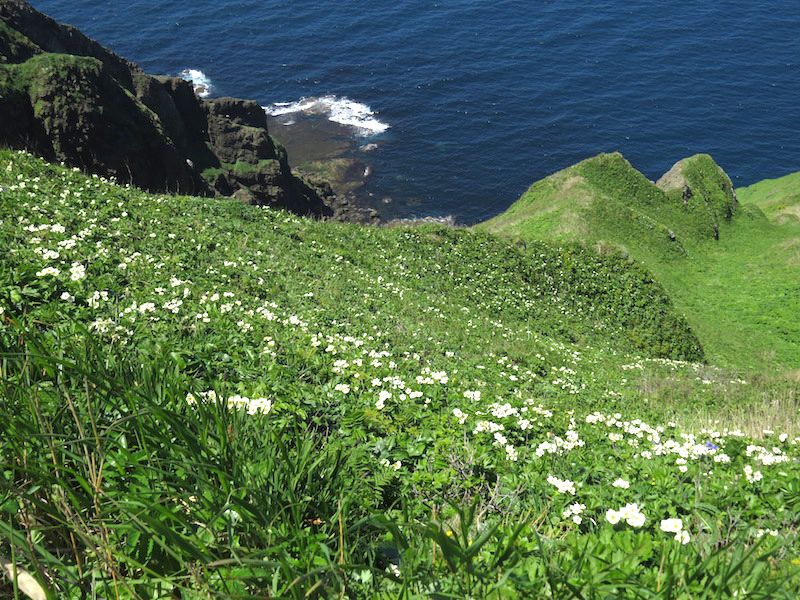
Anemone narcissiflora var. sachalinensis, a variety of anemone found blooming along the Momoiwa Observation Course.
The Cape Tour Course affords sublime views of the sea and the island’s northernmost promontories. If the visitor wants a more relaxed view, the Lake Kushu Course allows for strolling around the lake, located in the north of the island, through the meadows and along the walking path put in place through the shoreside marshes. The showpieces of the Rebun Forest Course are colonies of Rebun-usuyuki-sō, a type of leontopodium plants. The Rebun Falls Course passes through a valley with extensive colonies of Alpine plants on its way to the island’s largest waterfall. An ascent of the island’s highest peak via the Mount Rebun Course provides a view from 490 meters up not only of the entirety of Rebun Island, but also Rishiri, Hokkaidō, and Russia’s Sakhalin and neighboring Moneron Island.
By stringing together the Eight Hour Course, which includes changing views of meadows, forests, and coastal rocks, together with the Cape Tour, Rebun Forest, and Momoiwa Observation Courses, one can traverse the entire island in a day, covering a total distance of about 35 kilometers from Cape Sukoton, the northernmost part of the island, to Shiretoko, the southernmost. The trek reaches a maximum elevation of 300 meters, transversing many peaks and valleys, and thus is recommended for particularly hardy hikers. For reference, I needed a good 12 hours to cover the full route as described above.
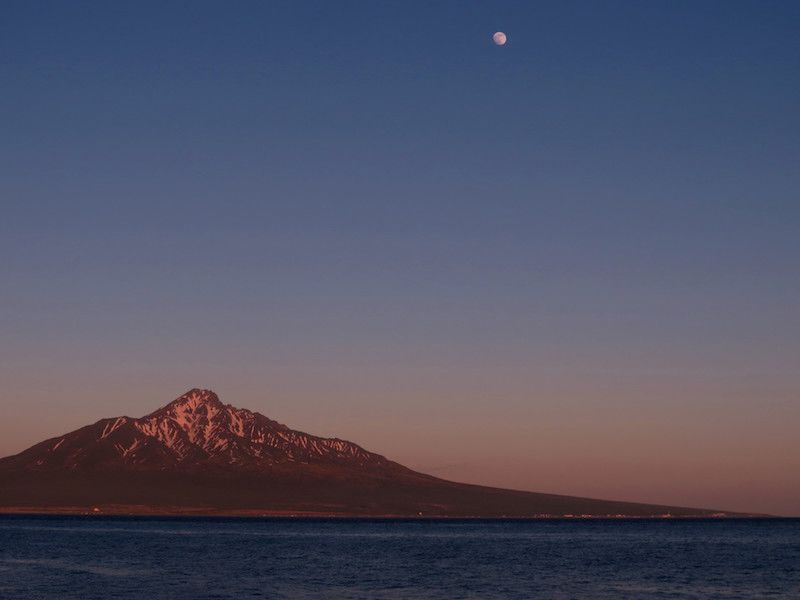
Mount Rishiri at sunset as seen from Shiretoko.
Information on which flowers are in bloom at a given time, as well as the state of the walking paths, can be easily obtained at Seikansō in the north of the island and either Momoiwasō Youth Hostel to the south or Guesthouse Hamanasu in Shiretoko. Seikansō holds after-dinner meetings where hikers share information about the courses walked that day, giving the next day’s walkers the latest updates. People also discuss where they are going to hike the next day, allowing people to get together and share the experience. Repeat visitors to the island can in some cases be better-informed sources of information than websites or guidebooks.
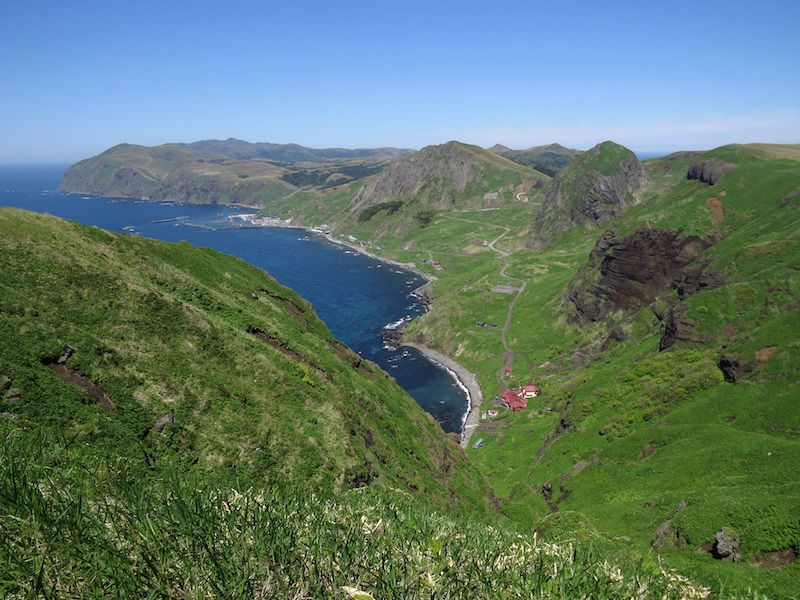
A north-looking view of the island taken from the Momoiwa Observation Course. Momoiwa, named for its peachlike shape, is the greenery-topped outcropping to the right; the red-roofed structures are the Momoiwasō Youth Hostel.
Only on Rebun Island
When asked what’s the prettiest flower I’ve ever seen, the pale cream-colored Rebun-atsumori-sō, a large lady’s-slipper, springs immediately to mind. My initial encounter with this flower, which blooms only on Rebun, was via a picture postcard that I spotted during an autumn 1972 visit to the island. The picture was of three cream-colored flowers, puffed up in the meadow, and seeming to smile a bit sheepishly. Enchanted on the spot, I vowed to return the following year.
The next June, said picture postcard in hand, I headed for Momoiwa, a treasure trove of Alpine plants. (The ecologically delicate site has since been closed to the public). Upon inquiring of a nature warden where the Rebun-atsumori-sō was blooming, I received the following pitiless answer: “Flowers that are targeted by illegal pickers are snatched up as soon as they bloom, so you’re probably out of luck.”
The place to go to be assured of seeing this flower was the colony in the wildlife preserve between Hamanaka and Teppu. I was determined to see this flower in the wild, however, and thus was thrilled when, relying on the image on the postcard, I found one such flower blooming on a steep cliff. After crawling to it on my hands and knees, I stared at its beauty, blowing in the wind, for what seemed like hours.
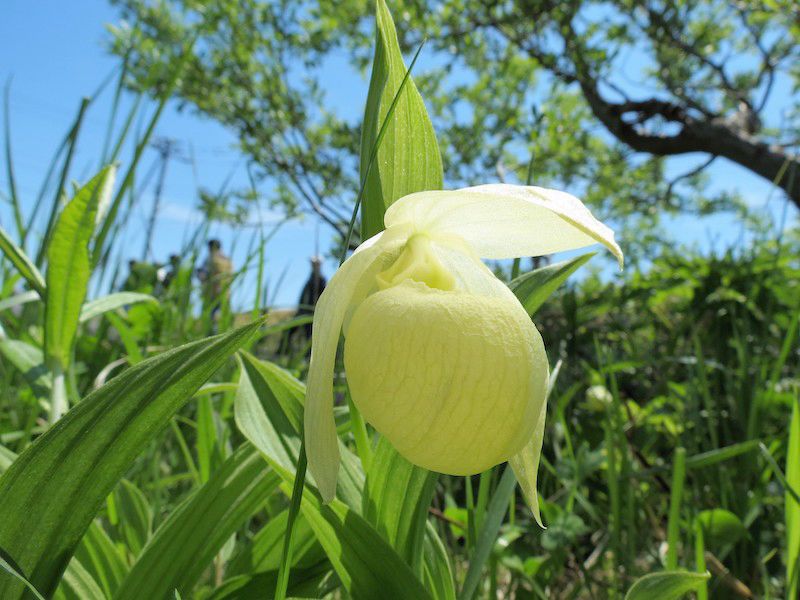
Rebun-atsumori-sō, which blooms only on Rebun Island.
I have visited nearly every year in recent times in search of this flower. The inn Seikansō in Sukoton is fully booked with Rebun-atsumori-sō pilgrims when the flower comes into bloom. Some people even schedule their annual vacations to coincide with the flower’s blooming period.
Research to increase the numbers of Rebun-atsumori-sō is underway at the Rebun Municipal Alpine Botanical Garden, resulting in large quantities of the flowers in recent times, though these seem rather feeble compared to the wild variety. While the initial head of the research effort spoke of selling seedlings one day to thwart the theft of the flowers in the wild, no such effort has come to fruition.
Possibly because of these dedicated preservation efforts, Rebun-atsumori-sō has been gradually increasing in number, such that a second colony site has been opened some 2 kilometers from the original. It is hoped that these increases will continue still further.
Rebun-atsumori-sō can be seen at the town’s Alpine Botanical Garden even in July or August, after its period of blooming in the wild has passed, owing to adjustments made to the timing of the blossoming of the flowers.
Uniquely Sweet Sea Urchins
Sea urchin fishing commences in the early summer, just as the Alpine flowers are coming into bloom. In early morning, when the seas around the island are becalmed, the banners go up and the calls resound in the fishing ports, and the waiting fishermen surge as one onto the waters. Upon reaching their respective intended fishing sites, they peer into the waters with wooden boxes featuring glass bottoms. When they spot urchins on the sea floor, they scoop them up with dip nets. Once they have at least a few in the net, they quickly hoist the catch into their boats.
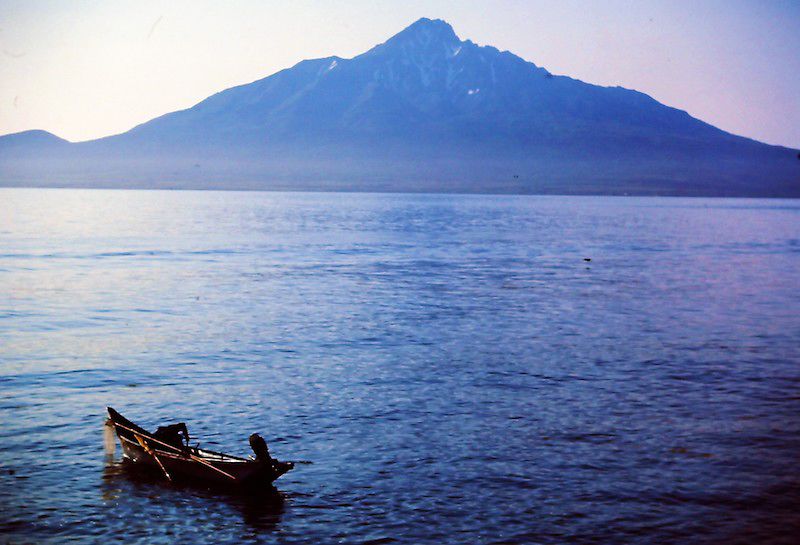
A Shiretoko fisherman catching sea urchins against a Rishiri-Fuji backdrop.
Skillfully working distinctive oars called kuruma-gai with their feet, the fishermen move to and fro in search of the sea urchins. One boat guns an outboard motor and travels several dozen meters, perhaps having gotten all the sea urchins to be had in the vicinity. The tension spreading among the fishermen despite the silence in which these one-person crews work is so thick you could cut it with a knife. In the time it took me to go back for breakfast at my lodgings and return to the seashore, the catch had wrapped up and the boats were also returning, one by one. They had been out fishing for all of about 40 minutes, being limited to short catch times in order to preserve the stocks. Hence, their haul depends entirely on the skill and stamina of the individual fishermen, making for a demanding contest indeed.
Among the fishing boats in the dock area, one fisherman, his face lined with deep wrinkles, has moved the small mound of sea urchins in the bottom of his boat, a mix of gaze (short-spined sea urchin) and nona (Strongylocentrotus nudus), to a basket-shaped container. What has his take been that day? “Not good,” he says. “The water’s all cloudy. It’s the first day of gaze season, but this is all I could get. Here, wanna try one?”
As he speaks, he splits a strangely squirming nona with a well-used makiri pocketknife and lays it on the side of the boat. Thanking the fisherman, I scrape the flesh out of its shell with a finger. It is viscous and falls apart at the slightest touch, and a sweet taste spreads throughout my mouth. This is exquisite eating.
Once you’ve had Rebun’s sea urchins, others just won’t do. I had been lectured boastfully about the taste of these from the master of an old, established luxury Japanese-style restaurant in the Nihonbashi district of Tokyo, who had only recently discovered it for himself. I understand, though; it’s so delicious that one feels compelled to tell others about it.
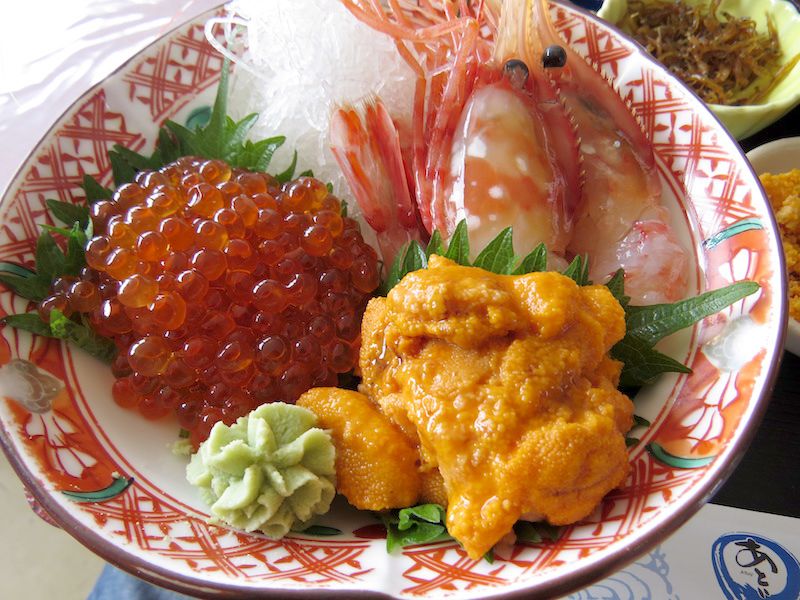
A sanshokudon (tricolor bowl) dish served at Atoi-shokudō restaurant: a combination of sea urchin, salmon roe, and botan shrimp.
At a nearby work shed, I spot an entire family shucking uni flesh out of the spiked shells. Perhaps the father is at sea; there are a grandmother and grandfather, a young boy, and the boy’s mother, baby lashed to her back. The boy tells me he is four years old as he skillfully cracks open an urchin with a sharp pocketknife.
“He’s been doing this with us since he was two,” explains his mother. “He would watch what the grownups were doing and demand to join in,” she laughs. The boy glances sheepishly at me from time to time as he continues the job, proudly holding each split urchin up in a gloved hand to show his family that he’s done it well once more.
Sea urchin stocks have declined even further over the past couple of years, so much so that there is even talk of imposing a ban on fishing for an indeterminate number of years. It is my hope that sea urchin hauls can be effectively controlled and their habitat maintained so that the supreme bliss of their taste can be enjoyed well into the future.
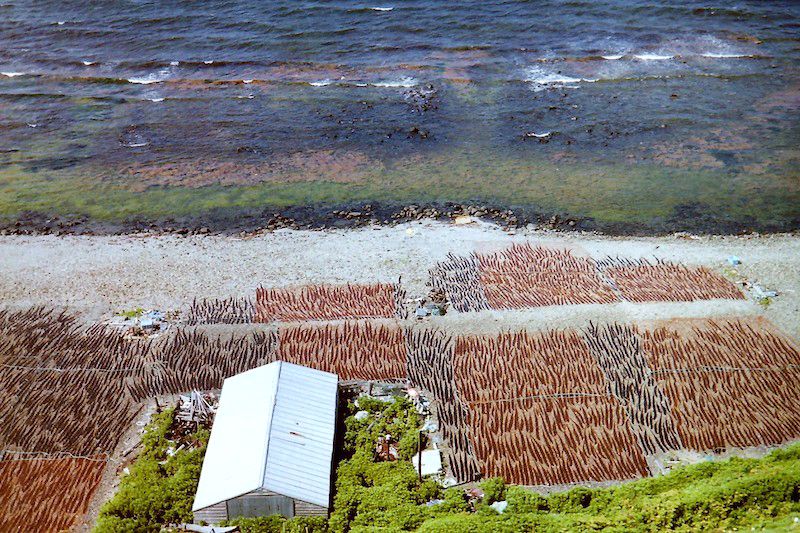
Konbu kelp drying at Awabikotan.
■Data
- Transportation: Around 2 hours by Heartland Ferry from Wakkanai Harbor
- Area: 81.33 square kilometers
- Population: 2,526 (as of December 2018)
(Originally published in Japanese on February 21, 2018. Photos and text by Saitō Jun. Banner photo: Cape Sukoton and Todo Island, as seen from the Cape Tour Course.)
